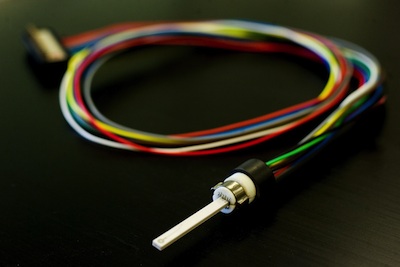
 EmiSense’s NOx sensor features a planar HTCC alumina insulator and yttria-stabilized zirconia sensing element with simplified geometry the company says should lower cost and improve durability. Credit: EmiSense
EmiSense’s NOx sensor features a planar HTCC alumina insulator and yttria-stabilized zirconia sensing element with simplified geometry the company says should lower cost and improve durability. Credit: EmiSense
As global automobile emissions regulations get tougher, exhaust gas sensors are evolving to meet increasing demands for accuracy, durability and real-time feedback of data to engine and emissions control systems.
Sensors for both nitrogen oxides and particulate matter are making use of high-temperature cofired ceramic sensor elements and other ceramic components, according to Patrick Thompson, CEO of EmiSense Technologies LLC (Ladera Ranch, Calif.).
Thompson says the company is working to improve sensor accuracy and durability while lowering cost by simplifying geometries of ceramic components and improving the signal processing elements of an integrated system for emissions measurement and control. EmiSense’s NOxTrac NOx sensor, for example, uses a planar HTCC alumina insulator and yttria-stabilized zirconia-sensing element capable of 1 to 2 ppm resolution.
“We want to supply a durable NOx sensor in the price range of current wideband oxygen sensors,” Thompson tells CTT. “Depending on volume, the current price of such oxygen sensors is $30 to $40, versus $100 to $150 for NOx sensors.” He expects major cost savings to come via simplified processing of the sensor geometry, possibly including a transition to dry pressing. The company is currently working on durability testing of the concept. Commercial rollout of the technology is expected for the 2016 model year at the earliest, Thompson says.
For diesels, another problem is particulate matter—the big puff of black smoke often seen on startup and during acceleration. EmiSense’s PMTrac sensor is aimed at meeting more stringent regulatory deadlines for soot that are just a few years away. Thompson said the device employs a novel design that enables the use of alumina as both a high-voltage electrical insulator, and also as an integrated heater, resulting in both improved long-term durability and lower initial cost. Operating without a sample pump over a wide range of exhaust gas velocities and temperatures, the sensor outputs a real-time signal that is stable even if ash and other contaminants accumulate on the electrodes. A brief video illustrating the operating principles of EmiSense’s soot sensor and resistive accumulator sensors is available here.
Testing at EmiSense and at Southwest Research Institute’s Particle Sensor Performance & Durability facility indicates the device’s output agrees well with reference laboratory instrument results over a wide range of conditions and particulate matter concentration levels.
On the business side of things, EmiSense recently closed its third round of funding, obtaining $6.5 million from 9th Street Investments to launch products, continue research and development, and support validation testing. 9th Street is a non-traditional venture capital group funded by CoorsTek, the Golden, Colo.-based supplier of advanced ceramics.
